Classé Delta Stereo and Delta Pre
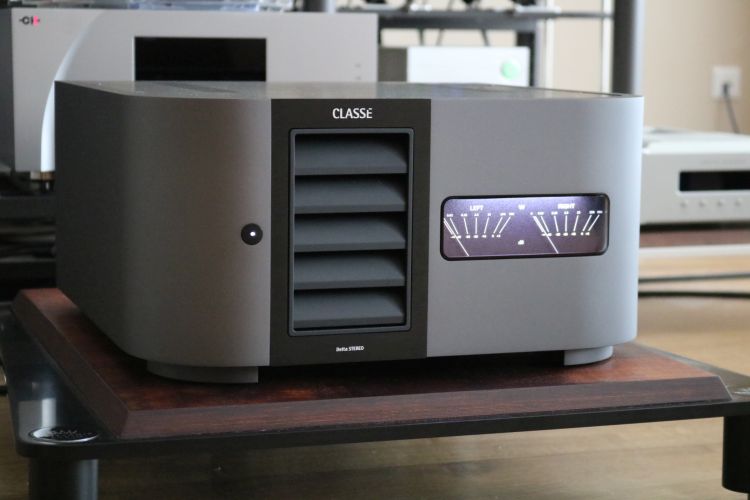
Review sample provided by Classé
Retail Prices in the Netherlands including 21% VAT:
Delta Stereo Pre: 14.000 euro
Delta Stereo Power: 11.000 euro
Founded in 1980, Canadian audio company Classé became part of the Bowers & Wilkins Group in 2001. In 2016 B&W was acquired by EVA Automation but only a year later the new owner ended all Classé activities in Montreal. For a moment, it seemed like that was it for the brand. Fortunately, Sound United emerged as the savior and the activities of Classé were resumed under the leadership of Dave Nauber.
Meanwhile, Classé had started developing the third generation of Delta products and this continued after the Sound United takeover. Production was moved from the B&W factory in China to the Shirakawa Audio Works factory, about 130 miles north of Tokyo in Japan, where the more upscale Denon and Marantz products are made.
The third-generation Delta product line includes the STEREO amplifier, MONO amplifiers and the PRE preamplifier with built-in DAC and streamer, and conceptually based on the CP-800.
In this review, I will first address the two units separately to assess their individual qualities and after that, I will see how they perform when combined.
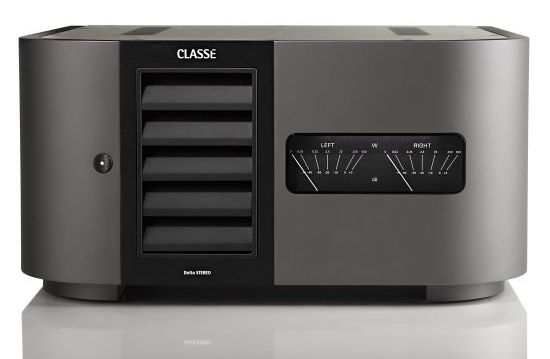
Power Amplifier Description
Although the curvy shape and the outer dimensions have been retained, the new third-generation line sports a stylish gray tone with black accents. On its cleanly designed front panel are two prominent features. First, the beautiful (and, unlike the Anthem STR’s meters, quickly-responding) VU meters (which show the average wattage) and, second, the ventilation opening which Classé calls the ICTunnel. This concept concerns a quadruple folded heat sink on which all transistors are mounted and through which an airflow is blown by means of an internal fan. This fan has a sensing circuit and rotates exactly as fast as necessary to keep the internal temperature constant. As long as there is music playing, you will normally not hear it. But in a quiet listening room and when playing no music or in between the tracks, you can perceive the familiar soft rustling sound of a fan and some purring bearing noise from the listening position (3.5 meters).
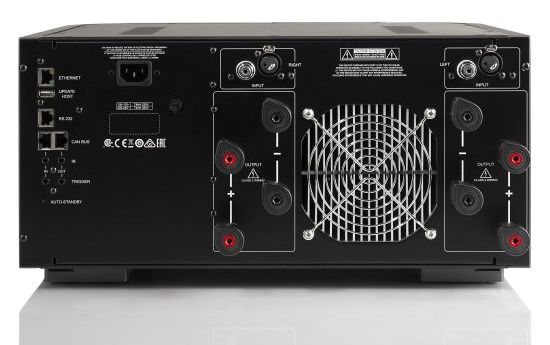
While the fan does speed up after the first hour of play, it only increases the wind noise and not the bearing grunt. While the wind noise at this higher speed is certainly audible anywhere in the room, the flow remains at a constant level and the pitch does not vary. And even when playing very loudly or after prolonged listening, the fan does not speed up further.
Upon checking with the manufacturer, Classé commented that the fan should not exhibit bearing noise and that my review unit may contain an out-of-spec fan.
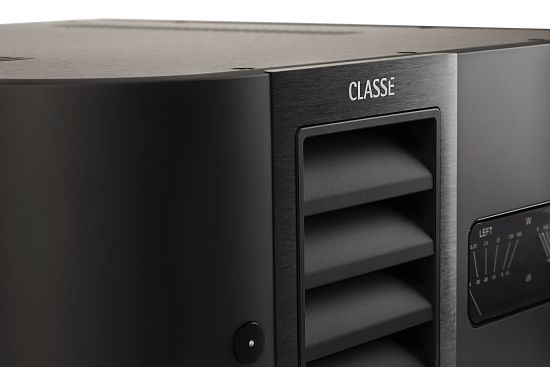
The big advantage of the airlock is that the amplifier housing remains remarkably cool. Large parts of the device feel cold even after hours of play, while a constant and quite warm airflow can be felt at the back. This makes it easy to place the amplifier in a rack, as long as the rack at the back is partially open, and you can place devices on top of the amplifier without any problems. That is something that you should not do with a convection-cooled amplifier and certainly not with one such as the Classé which is up to 12.5 Watt in Class-A and therefore always gives off heat, even when no music is being played.
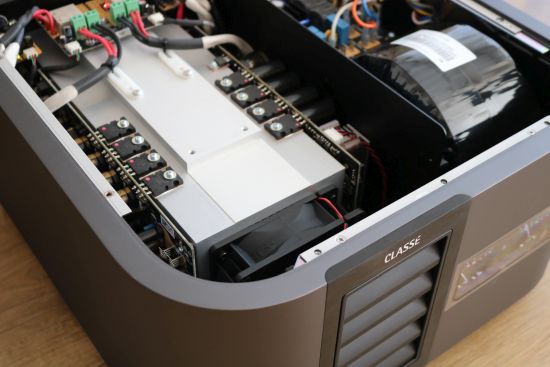
Power Reserve
One of the core goals of the new amplifier design was to reduce the focus on extremely high wattages, in favor of a considerably higher power reserve. Nevertheless, the amplifier still delivers more than 250 Watts in 8 ohms and 500 Watts in 4 ohms in class A/B. As should be common knowledge by now, the amount of watts is only one aspect and it says very little in itself. When controlling difficult speakers, the most important aspect of an amplifier’s design is how stable its power supply is. All it takes is a peek at the amplifier’s internals to know Classe means business! At almost 53 kilos, the amplifier is very heavy and if you look at its transformer you instantly know why. This amplifier contains the largest toroidal transformer that I have ever seen inside an amplifier. With reportedly half a kilometer of wire and a weight of almost 14 kilos all by itself, it forms a very serious foundation of the amplifier.
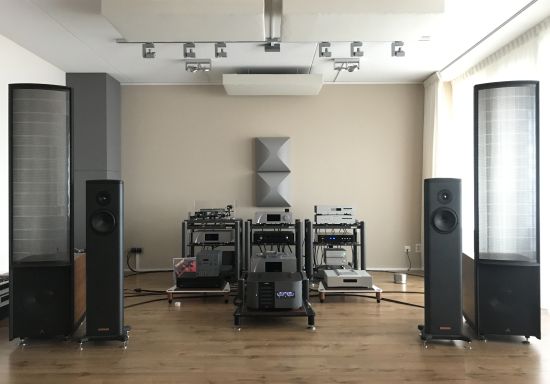
The Martin Logans that can be seen in the image above have not been used within the context of this review. For the most part, they were moved out of the way to give the Magicos all the room to breathe freely.
Listening
Fresh out of the box with zero hours on its counter, placed directly on an Artesania platform, fed by the Antipodes K50 Music Server and CH Precision C1 DAC and, and connected to Magico S1 MkII speakers via Driade Flow 405 speaker cables, the amplifier immediately sounds satisfyingly robust and pleasingly grunting in the bass. There’s a beautifully articulated and voluminous quality at the same time. The pacing is perfect, not slow nor rushed. The midrange is very natural and convincing in timbre, although I do notice a slight coolness now and then and some hardness here and there. This, I would later find, can be attributed entirely to the required running-in. Nevertheless, the sound immediately involves me such that I blissfully ignore the edge and raise the volume some more. Wow, the Classé certainly has no problems playing at storm-levels! The amplifier has the kind of unshakable authority that makes one want to push its limits, only to find that there seemingly is no limit!
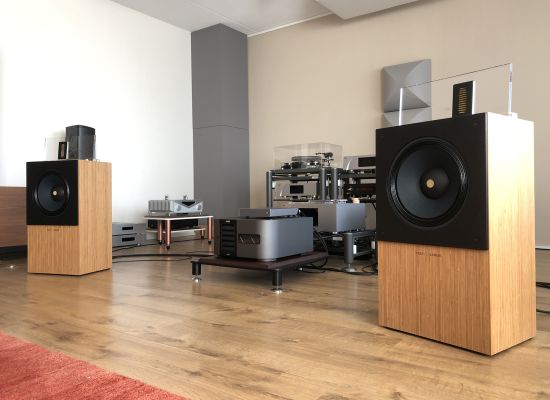
Wolf von Langa SON
One might argue that the cutie S1’s don’t need a beast of an amplifier anyway. But as I know from the CH Precision A1.5 amplifier and its Watts-readout that with a little (well, ok, a LOT) enthusiastic playing, a whopping 450 Watts easily disappear into these speakers. Speaking of which, the big Swiss amp certainly also has great grip on the speakers, but it has a different character than the Classé. It is incredibly articulate and highly neutral and even-handed. Some find its clean balance and utter neutrality to result in a sound that is a little too lean and I agree that you could state that its bass is a little on the slim side compared to certain other amps that I reviewed, such as Bryston, Electrocompaniet and McIntosh. Indeed, these other amps also have a richer and fuller-sounding midrange, but in my view, the A1.5 is not lacking; the others are deviating from neutrality.
The Classé is also very neutral and very linear but by no means slim. Maybe it’s even a bit more robust and fuller in the bass than I would regard as strictly neutral, but with the Magico S1’s, the balance is just right. The bass is enormously powerful as well as fabulously detailed, a combination that you don’t often hear.

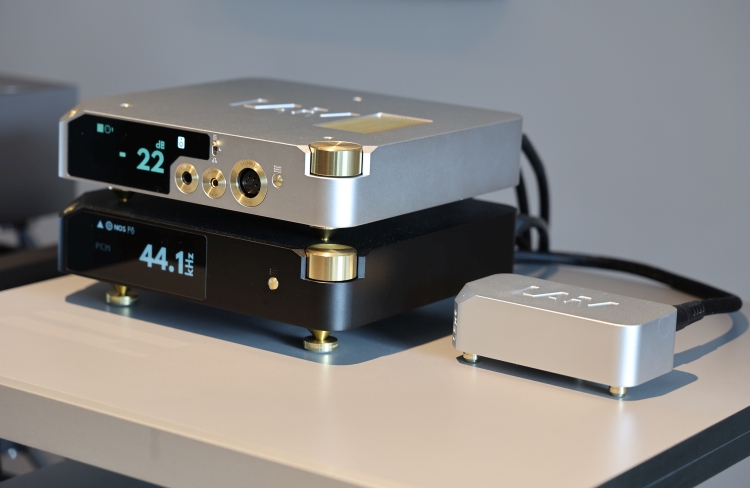






Christian,
Another super thorough well written review thank you. On your description of the Delta pre and it’s Dac I am sure I’m misreading but it sounds like you’re saying the Delta isn’t resolute enough to differentiate between Dacs. Given how much you liked the preamp I’m sure that’s not the case and I’m misconstruing what you wrote.
Thanks,
Jon
Hi Jon, although you can find a preamp that is more transparent and it does add a little bit of its own character, the Delta Pre actually has very good resolution. It’s more that the built-in DAC just works so well that there is little to gain by using an external DAC. What happens is that you only move sideways. I’ve encountered this before with preamps and amplifiers with built in DACs, where it seems there is often (indeed not always) a special synergy or advantage to using the built-in DAC.
Christiaan,
I did have a chance to test the Classé Delta Pre + Classé Delta Stereo Power Amp at home for a week, so I was extra curious to find out if we had similar findings. The fan noise was too loud for me. No need to look for dark background in other components if you have a fan noise killing all of it.
I personally don’t think fans belong in high end audio components for home use.
I found it to be rather even in the frequency delivery but I lacked some speed in the transients. High quality design and material but I think the price was too high compared to the performance. Bass delivery wasn’t to my liking at lower volume levels. Belting out music at loud volumes without any strain my be favorite working day for the Classé.
Also very narrow angle of response for the remote. For this amount of money there are other more tempting options, in my book.
I also missed texture in the midrange that is one of the Analog Domain M75D highlights.
Christiaan I realize that it has been three years since you reviewed the AD and that you have maybe shifted your preference to even more neutrality. From sonic memory and your old notes would you today consider that AD midrange texture as colored or neutral?
Do you have any suggestions for audition if I like a similar midrange texture and richness as the Analog Domain M75D but a little bit more open and airy in the top? And maybe a tad less dry bass, if I can wish three things 🙂
Will you have a Vinnie Rossi review coming up? Seen it sitting in your room for a while now.
Stay safe.
Hi Per, a friend has Analog Domain, and so, the delivery remains vivid in my mind. It’s not colored in any way. CH is not really more neutral either, mostly just more refined and more highly resolving. I feel that Analog Domain is very neutral and, while controlled, also natural, with a pure and open, communicative midrange. I find it to be very realistic, not enriched or smoothed or warmed up in any way, nor hardened or edgy. Yes, the bass is a little dry, certainly compared to the Classe’s, and I also agree on the treble being dark. As for alternatives that retain the AD strengths while not having the deficiencies, the next step up for me was the CH, I’m afraid. Vinnie Rossie will issue an updated model that I will review.
Thank you for your comments Christiaan.
I forgot to mention that I also find the AD to be a little too polite. I miss some of the transient attack.
The best I have heard the AD is in a system that has a DCS DAC stack feeding it and driving a pair of Marten Coltrain. The room was a dedicated listening room but fairly small 20-25 m2. The owner also likes to play very loud. 90-95% of max. volume on the AD M75D. The sound was fabulous and non fatiguing to listen to even at very high volume levels. I think it was partly due to the dryer bass in the AD the Coltrains didn’t overpower the small room with too much bass. And the “gentle” treble of the AD never felt piercing even though it was VERY loud.
But in my home with my TAD CE-1 speakers I was missing a little immediacy/attack at my much lower listening levels (living in an apartment). Is CH or Audio GD more snappy than AD? I’m also curious to what Soulution 330 could bring to the table. I know you have many times referred to the Soulution 711 power amp. Have you heard the 330? With your long term exposure to both CH and Soulution what would you say differ them sonically? Do both have a midrange that is on the same organic, timbre and textured level as AD?
I have tested so many amplifiers, some rather expensive with separate pre and mono blocks, but have so far always been missing the natural qualities of the AD midrange. The reason I asked you if you considered the AD midrange to be “neutral” or colored is that so many other amplifiers sound rather unnatural and lifeless in comparison. It has almost become a brain ghost for me. There is of course no perfect amplifier out there but I’m still hoping to find one that ticks my boxes and have the compromises that I can accept.
Keep up the great work with your reviews and I will keep a special eye out for that Vinnie Rossie one.
Hi Per, as this thread developed, we moved a little bit too much beyond the topic of this comment section. It’s ok for now but for follow-up questions (if not related to Classe), it will be better to discuss them under more related articles.
CH is not snappier or more immediate than AD. The Classe is, and so is AGD. For a comparison between the 711 and the A1.5, please see this mini-review. I haven’t heard the 330 but the 711 is not snappier than Classe or AGD. Amps that are, usually deviate from neutrality. I’m not sure if I had already mentioned the Anthem STR? That’s the snappiest amp I have heard. It’s got tight bass and a similarly neutral midrange but it is drier and edgier than all the aforementioned amps. See the review for the specifics. Oh, the Vinnie is also quite snappy but I’ll have to wait for the updated version to reach a conslusion. In conclusion, may I ask if you found the Classe to be snappy/lively enough? If not, then I fear that the amplifier may not be the culptit in your system.
Hi Christiaan,
As you wrote ”- While on this subject I also noted that the amp sounds best when playing a little louder. At lower volume, it loses some of its finesse and becomes a little less exciting.” I also found the Classé to be lively enough on moderate to louder volume levels but losing its excitement and pros on lower volumes – to a higher degree than some other amps.
I should also factor in that with lower volume levels the disturbing fan noise made me loose excitement over the Classé and I would possibly judge the sound different if it had been quiet.
I will return with further comments under more related articles, as per your suggestion.
Thanks.
Hi Per, the Classe is not hyper-detailed nor very finely resolving which adds to it sounding better when playing a little louder. This also makes the fan less noticeable. When playing a little louder, I really like its propulsive sound and it sure LOVES to play at even louder levels. Nevertheless, I agree that the fan remains an important factor to consider.
Hello , i use Classe CP-800 with CA-2300 (previous series ), i can tell you how i resolve fan noise , when i listen misic , i put one pillow in front and another in back of amplifiers , without stop air flow . BR
Yup, that will surely reduce the noise but I don’t think it is good for the amp’s health. Capacitors age faster when hot.
Hi Christiaan,
as always very good review that does not fall short when pointing on things not so great. A rare and difficult to do thing as reviewers depend on review samples.
But you still gave the Classe a fair review which even Classe should find positive.
I am seriously intreagued by the new Classe Delta and i have one question.
I was thinking the great sound of the Classe is due to the fact that it runs in class A almost all the time. You said they sound better when played louder.
Did you ever notice a difference in sound when the amp goes into class a/b ?
I wonder if i would be better up buying the Mono amps instead because with 35W class A they should never need to switch to a/b (unless you rock loud).
What do you think ? Mono or Stereo ?
Thanks.
Markus
Hi Markus, Alas, there is no way to tell when the amp goes from Class-A to Class-AB. That said, I don’t think this is the main reason why the amp sounds the way it does. By that, I mean that I think its character is inherent to its overall design and more likely the result of decisions made in the power supply and driver stages than on the Class-A concept. Of course, Class-A does propvide theoretical benefits in that there is no crossover distortion which can be audible as a lack of hardness/edge. While I have not compared the Classe Delta stereo to the monos, usually, when increasing the number of output devices results in a higher power rating along with other obvious benefits. But unless the monos are simply the contents of the stereo amp divided over 2 chassis, depending on the exact changes, this can also influence the character or nature of the amp. It is possible that the monos sound tighter or leaner, or alternatively perhaps slightly more diffuse, or less refined. Or they could be better overall. I just don’t know. The only way for you to know is to try both options. If you do happen to make this comparison, do let me know what you think!
tx for your response. even though you left the question partially unanswered (how could you when you could not make the direct comparison) i appreciate it.
It helped in the way that you pointed out that you guess they will more likely sound the same than different (because of design choices) and that class a/b or not might not be a concern. I want to buy used so i might not be able to make that comparison that is why i was curious 🙂
If i am able to i will report.
Tx again.
Markus
I also experienced something that was never true years ago …
that the stereo amp can sound even better than the mono versions in ones system.
Hi Markus, Having double power supplies is almost always a very good idea, especially with power-hungry speakers. But depending on the internal changes, a stereo amp can indeed sound subjectively better than the mono version. It depends on which aspects of the performance are found to be most important to the listener. Please note that there is a difference between technical or audiophile aspects, and the overall character. I would assume the stereo and mono Classe amps have the same basic character but there will surely be differences in some fields. Just which differences I cannot say without having compared this myself. Happy hunting!
One last question about the Delta Pre. I saw it was also a recommended product in the DAC list. I assume it means that the Delta Pre has a very good DAC, too.
I use a Audiovalve Solaris as Pre and it has a super DAC i think. I also have the latest Macintosh CD Player with their latest DAC, too. The Solaris beats it easily that is how good it sounds.
Do you think one can happyly live with the Delta DAC or will it feel like the bottle neck (compared to the rest of a high price and quality system) ?
I think the Delta pre has a great DAC on board, certainly at the price. There are better DACs but they will cost as much as the Delta pre itself or more.
Hi Christiaan,
I love the reviews on this site and I found, as an owner of the Delta PRE, that your description matches my experience almost exactly!
I’m looking at upgrading to another DAC and I was looking for something with similar character as the Delta PRE, which I find to have a great bottom end (warm?) and extremely non-fatiguing to listen to.
I’ve tried a host of other DACs including the Tambaqui and dCS Rossini APEX and found them fatiguing despite improvements in detail and soundstage.
Any recommendations up to ~$20k for a DAC that would improve detail and soundstage but retain the non-fatiguing listening experience I love?
Thanks!
Nice feedback, thanks. Accuphase DC-37 is very smooth and rich, and relaxed, but well detailed. APL could be an option, and if tubes are on the table then you could consider the Aries Cerat Helene.
Thanks Christiaan. One more – how about the Aqua DACs? Especially La Scala with the tubes? Thanks again
The Aqua La Scala is precise, lively, and expressive, not really lush, smooth, or warm, which I think is the “non-fatiguing” sound you are after. That said, for me it is one of the best DACs in its price range.
Great Review Christiaan, I own a pair of Classe Delta Mono’s that drive my new Wilson Audio Alexx V’s. I have a VAC Sig Mk2 SE as a Pre. It sounds wonderful to my ears. However, I can’t help think I’m missing something with these amps. Thinking of moving to CH or something similar but am concerned the delta in SQ would be small compared to the amount I would have to spend. What do you think? Any recommendations would be appreciated. Love your site!
Hi Scott, I would not classify the difference between Classe Delta and CH Precision as small. Yes, you pay considerably more, but you also get more. It is diminishing returns as always, but here, we are talking amplifiers with different skillsets. The CH amp(s) is/are worth aspiring to if you are looking for higher resolution, more air, more refinement, nimbler/more lightfooted/faster bass, and overall more sophistication. I think even a single A1.5 would drive the Alexx very well but CH amplifiers have less “bombastic” slam than the Classe. They can definitely rock but they are not Krells or Brystons in that respect.
I may have missed it, but do you remember which of your power cables was used on the power amp?
I think that must have been a Belden 19364 with Bals Schuko and Oyaide C-004 IEC.
Thanks
I have a Delta hence my curiosity. The front end is likely to change to a Grimm MU2, then I will try out some alternative power cables. Gigawatt will be among them, and probably the Mad Scientist Ultra.
Hi, Christiaan-
Wonderful review. Your reviews assist me more than any other online or magazine based audiophile reviews. I am considering purchasing a Delta Stereo amplifier, but I am curious to how it would compare to a class A or AB Accuphase or Esoteric amplifiers (I am not sure if you have reviewed Esoteric gear)? To me, Accuphase is a very rich sounding amplifier and Esoteric has a strong, almost hard tone sound. I have been told that the Delta Stereo is somewhat in between or has the best qualities of both the Accuphase and Esoteric… with none of the deficits… kind of a happy medium. Any additional insights that you could provide would be greatly appreciated. Thank you.
Thanks for the nice feedback! 🙂 I’ve not heard Esoteric amplification in a controlled environment but I think what you’ve been told makes sense. Most Accuphase amps are indeed quite smooth, some too much so for my taste. The Classe Delta is both: smooth yet robust, solid, and expressive, not hard but also not too laidback.